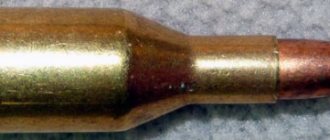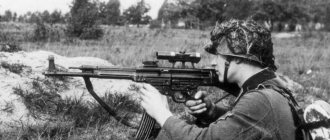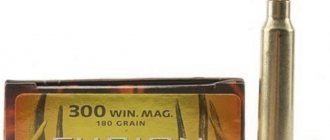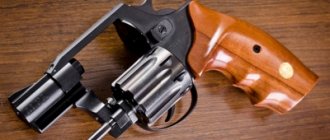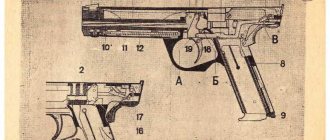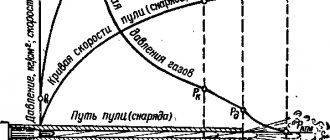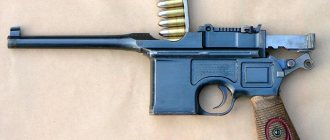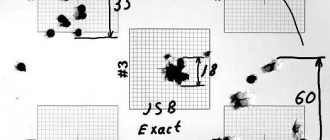Russian cartridges
Large-caliber small arms, and primarily large-caliber machine guns, appeared on the battlefields of the First World War. It was a response to the widespread use of armored vehicles and the appearance of the first tanks. The development of aviation and its use to destroy ground targets required, in turn, the creation of means to combat it. That is why the nascent air defense of the ground forces and navy at that time was also partially entrusted to heavy machine guns. In the 1930s and 40s, heavy machine guns found widespread use in aviation.
In the USSR, the design of a large-caliber cartridge began in 1927. The first domestic large-caliber cartridge was created at the Tula Cartridge Plant and put into service in 1930. It received the name 12.7 mm cartridge with an armor-piercing bullet of the 1930 model (B-30). Subsequently, to expand the capabilities of large-caliber machine guns, new types of cartridges with armor-piercing incendiary, armor-piercing incendiary tracer, incendiary, sighting and other types of bullets were created. Their development was carried out first at the Tula and then at the Ulyanovsk cartridge factories, at plant No. 46 and OKB-44 (both located in Kuntsevo, Moscow) and at the Federal State Unitary Enterprise TsNIITOCHMASH.
Currently, there are several types of 12.7 mm cartridges in service, which are used for firing from heavy machine guns DShKM, NSV-12.7 "Utes" (NSVT and NSVS), "KORD", YakB-12.7 and large-caliber sniper ASVK "KORD" and OSV-96 rifles. The production of 12.7 mm cartridges has been established at the Novosibirsk and Ulyanovsk cartridge factories. All types of 12.7mm cartridges are available with a brass case.
Cartridge with armor-piercing incendiary bullet - 12.7 B-32 (57-BZ-542 and 7-BZ-2)
Cartridge with armor-piercing incendiary bullet - 12.7 B-32 (57-BZ-542 and 7-BZ-2)
The cartridge with the B-32 armor-piercing incendiary bullet was created by the designers of Plant No. 46 to replace the cartridge with the B-30 bullet and was put into service in 1936. This name for the cartridge - B-32 - was chosen because it was made similar to the 7.62 mm B-329 rifle cartridge adopted for service in 1932.
The 12.7 B-32 cartridge is designed to destroy lightly armored targets, live targets and fire weapons located behind light cover, as well as low-flying aircraft and helicopters at a range of 1500 m.
Penetration of armor is carried out by a core made of high-strength heat-treated steel. The incendiary effect is provided by a pyrotechnic incendiary composition located in the head of the bullet in front of the core.
The bullet of this cartridge penetrates 20-mm armor at a distance of 100 m and ensures the ignition of fuel (gasoline and aviation kerosene) after penetrating the light armor protection of combat vehicles and combat helicopters at long ranges. The head of the bullet is black, with a red belt.
Armor-piercing incendiary bullet cartridge 12.7 B-32
Main characteristics of the 12.7 B-32 cartridge
Cartridge mass, g: 133.5 Bullet mass, g: 48.2 Cartridge length, mm: 147 Initial bullet speed, m/s: 818
Cartridges with armor-piercing incendiary tracer bullets - 12.7 BZT-44 (57-BZT-542) and 12.7 BZT-44M (57-BZT-542M)
Cartridge with armor-piercing incendiary tracer bullet - 12.7 BZT-44 (57-BZT-542)
The 12.7 BZT-44 cartridge was developed at OKB-44 and put into service in 1943 to replace the cartridge with the BZT armor-piercing incendiary bullet (its manufacturability was improved, the brightness of the tracer and the tracing range were increased).
The modernization of the 12.7 BZT-44 cartridge was carried out at FSUE TsNIITOCHMASH in the early 1990s. The new cartridge was put into service in 2002 and received the name 12.7-mm cartridge with a modernized armor-piercing incendiary tracer bullet BZT-44M. In the modernized bullet, the tracer ignites at a distance of 50-120m from the muzzle of the barrel. This makes it difficult for the enemy to detect the firing position, does not blind the shooter and reduces the illumination of night sights.
The 12.7 BZT-44 and 12.7 VZT-44M cartridges are designed to engage low-flying air targets, lightly armored vehicles, vehicles and group live targets, as well as for shooting adjustments and target designation. These cartridges can be used to start fires. Cartridges 12.7 BZT-44 and 12.7 BZT-44M are usually used for firing from anti-aircraft machine guns in conjunction with the B-32 cartridge.
Bullets from 12.7 BZT-44 and 12.7 BZT-44M cartridges penetrate 15 mm thick armor plates at a distance of 100 m and ignite the fuel behind the armor.
The pointed core of the bullet is made of heat-strengthened tool steel. The incendiary composition is located in the head of the bullet in front of the core. The tracer is pressed into a cup and is located behind the core. The head of the bullet is purple with a red belt.
Armor-piercing incendiary tracer bullet of the 12.7 BZT-44 cartridge
Main characteristics of the BZT-44 cartridge
Cartridge mass, g: 128 Bullet mass, g: 44 Cartridge length, mm: 147 Initial bullet speed, m/s: 818
Cartridge with armor-piercing incendiary bullet - 12.7 BS (7-BZ-1)
Cartridge with armor-piercing incendiary bullet - 12.7 BS (7-BZ-1)
A cartridge with an armor-piercing incendiary bullet BS (BS - armor-piercing core) was developed at the Federal State Unitary Enterprise TsNIITOCHMASH and put into service in 1974. It is designed to engage lightly armored targets, live targets and fire weapons located behind light cover, as well as low-flying air targets.
The BS bullet has significantly better armor-piercing effect than the B-32 bullet. At a distance of 750 m, it is capable of penetrating 20 mm armor at an angle of 20 degrees from the normal. This level of armor penetration allows you to successfully hit targets like the M-113 armored personnel carrier at a distance of 700-800 m.
The increased penetrating effect of this bullet is ensured by the use of a metal-ceramic core. To increase the incendiary effect of the bullet, the pyrotechnic incendiary composition is located not only in the head of the bullet in front of the core, but also in a special cup after it.
The color of the bullet is red until the bullet is crimped by a cartridge case with a black head.
Armor-piercing incendiary bullet cartridge 12.7 BS (7-BZ-1)
Main characteristics of the 12.7 BS cartridge
Cartridge mass, g: 141 Bullet mass, g: 55.4 Cartridge length, mm: 147 Initial bullet speed, m/s: 818
Cartridges with an instant incendiary bullet - 12.7 MDZ (7-3-2)
Cartridges with an instant incendiary bullet - 12.7 MDZ (7-3-2)
The 12.7 MDZ cartridge (MDZ - instantaneous incendiary) was developed by specialists from the cartridge plant in Ulyanovsk. This cartridge is designed to destroy low-flying air targets from anti-aircraft machine gun installations. It can also be used to create fires. The incendiary bullet cartridge is usually used in conjunction with 12.7 B-32 and 12.7 BZT-44M cartridges.
When a bullet hits an obstacle, a pneumatic impact fuse is triggered, which initiates an explosive charge. This ensures the penetration of duralumin sheets 2-3 mm thick with the formation of a hole with a diameter of 30-40 cm and the ignition of kerosene or gasoline in the fuel tanks of aircraft or helicopters.
The color of the bullet is red up to the point where the sleeve is crimped.
Instant incendiary bullet cartridge 12.7 MDZ
Main characteristics of the 12.7 MDZ cartridge
Cartridge mass, g: 127 Bullet mass, g: 43 Cartridge length, mm: 147 Initial bullet speed, m/s: 828
Two-bullet cartridges - 12.7 1SL (9-A-4012) and 12.7 1SLT (9-A-4427)
Two-bullet cartridge - 12.7 1SL (9-A-4012)
Two-bullet cartridge - 12.7 1SLT (9-A-4427)
Two-bullet cartridges 12.7 1SL and 12.7 1SLT (tracer) were developed at the Federal State Unitary Enterprise TsNIITOCHMASH and accepted for supply to the Air Force in 1985. The creation of such cartridges and weapons for them was caused by the need to significantly increase the density of machine gun fire from combat helicopters on ground targets in order to increase the likelihood of hitting the target.
These cartridges are used during firing from four-barreled YakB-12.7 aircraft machine guns mounted on Mi-24D5 combat helicopters and are intended to destroy living targets, ground-based unarmored vehicles and fire weapons. The cartridge with the 12.7 1SLT tracer bullet is used in conjunction with the 12.7 1SL cartridge and, in addition to hitting the listed targets, provides shooting adjustment and target designation.
Both bullets of the 12.7 1SL cartridge are armor-piercing incendiary with a steel core. In the 12.7 1SLT cartridge, the front bullet is the same as in the 12.7 1SL cartridge; and the back one is incendiary and tracer. When chambering, the tip of the rear bullet fits into a notch in the tail of the front bullet. The second bullet is secured to the cartridge case by punching the cartridge case in three places.
The 12.7 1SL bullet has no coloring. The color of the 12.7 1SLT bullet is green.
Two-bullet cartridge - 12.7 1SL (9-A-4012) cross-section
Bullet of a two-bullet cartridge 12.7 1SLT
Main characteristics of the cartridge 12.7 1SL / 12.7 1SLT
Cartridge mass, g: 145 / 142 First bullet mass, g: 31 / 31 Second bullet mass, g: 31 / 27 Cartridge length, mm: 147 / 147 Initial speed of the first bullet, m/s: 735 / 730 Initial speed of the second bullet , m/s: 680 / 700
Sniper cartridge - 12.7 CH (7N34)
Sniper cartridge - 12.7 CH (7N34)
In the 1990s, interest in large-caliber sniper weapons increased significantly throughout the world. Such a weapon in the West is often called an anti-materiel rifle - a rifle for destroying weapons and military equipment. The creation of new weapons in Russia began only in the late 1990s.
The large-caliber sniper cartridge was developed at the Federal State Unitary Enterprise "TSNIITOCHMASH" with the participation of the Novosibirsk and Ulyanovsk cartridge factories. It is designed for firing from sniper rifles and ensures the destruction of live targets, unarmored and lightly armored vehicles at a distance of up to 1500 m.
The sniper cartridge bullet has a composite core consisting of a steel and lead part. The steel core is located at the head of the bullet. It is made of heat-strengthened tool steel and ensures destruction of lightly armored vehicles at a distance of 1500 m.
Production of the cartridge began in the early 2000s, first at the Novosibirsk and then at the Ulyanovsk cartridge factories.
Sniper cartridges do not have a distinctive color.
Bullet of sniper cartridge 12.7 CH (7N34)
Main characteristics of the 12.7 CH cartridge
Cartridge mass, g: 147 Bullet mass, g: 59 Cartridge length, mm: 147 Initial bullet speed, m/s: 785
12.7mm Blank - 12.7 BLANK (7X1)
12.7mm Blank - 12.7 BLANK (7X1)
Blank cartridges are designed to create the sound effect of firing from heavy machine guns when training personnel.
To fire blank cartridges, a device for blank firing is used (a muzzle tube and inserts in the machine gun receiver and in the cartridge box), which ensures the operation of the moving parts of the weapon's automation. The shot is accompanied by sound, a flash of flame and smoke.
A blank cartridge differs from a combat cartridge in the absence of a bullet and the shape of the cartridge case, which is made in the form of a hemisphere to ensure that the cartridge is chambered. The cartridge case is closed with a cap made of special cardboard. The blank cartridge is shorter than the live cartridge, its length is 112 mm. Blank cartridges are produced with a brass sleeve.
Training cartridge - 12.7 UC (7X2)
Training cartridge - 12.7 UC (7X2)
The training cartridge is intended for teaching the rules of handling cartridges, equipping machine gun belts, methods of loading weapons and firing a shot.
The 12.7 UCH cartridge is made using the main parts of the 12.7 B-32 cartridge, but does not contain a powder charge or incendiary composition and has a cooled igniter primer. The cartridge is available with a bimetallic or varnished steel sleeve. Increasing the strength of the bullet fastening in the cartridge case, in order to prevent it from falling out during training for loading weapons, is ensured by additional crimping of the barrel onto the bullet.
The training cartridge bullet does not have a distinctive color, but the cartridge case has four symmetrically located longitudinal grooves.
« back | menu | forward "
DShK machine gun – video
With the start of work on a machine gun with a caliber of 12-20 millimeters in 1925, it was decided to create it on the basis of a magazine-fed light machine gun in order to reduce the weight of the machine gun being created. Work began at the design bureau of the Tula Arms Plant on the basis of the 12.7-mm Vickers cartridge and on the basis of the German Dreyse (P-5) machine gun. The design bureau of the Kovrov plant was developing a machine gun based on the Degtyarev light machine gun for more powerful cartridges. A new 12.7-mm cartridge with an armor-piercing bullet was created in 1930, and at the end of the year the first experimental large-caliber Degtyarev machine gun with a Kladov disc magazine with a capacity of 30 rounds was assembled. In February 1931, after testing, preference was given to the DK (“Degtyarev large-caliber”) as easier to manufacture and lighter. The recreation center was put into service; in 1932, a small series was produced at the plant named after. Kirkizha (Kovrov), however, in 1933 only 12 machine guns were produced.
Military tests did not live up to expectations. In 1935, production of the Degtyarev heavy machine gun was stopped. By this time, a version of the DAK-32 had been created that had a Shpagin receiver, but tests in 1932-1933 showed the need to refine the system. Shpagin remade his version in 1937. A drum feed mechanism was created that did not require significant changes to the machine gun system. The belt-fed machine gun passed field tests on December 17, 1938. On February 26 of the following year, by resolution of the Defense Committee, they adopted the designation “12.7-mm heavy machine gun mod. 1938 DShK (Degtyarev-Shpagina large-caliber)” which was installed on the Kolesnikov universal machine. Work was also carried out on the DShK aircraft installation, but it soon became clear that a special large-caliber aircraft machine gun was needed.
The automatic operation of the machine gun was carried out due to the removal of powder gases. A closed gas chamber was located under the barrel and was equipped with a pipe regulator. The barrel had fins along its entire length. The muzzle was equipped with a single-chamber active-type muzzle brake. By moving the bolt lugs to the sides, the barrel bore was locked. The ejector and reflector were assembled in the gate. A pair of spring shock absorbers of the butt plate served to soften the impact of the moving system and give it an initial rolling impulse. A return spring, mounted on the gas piston rod, activated the impact mechanism. The trigger lever was blocked by a safety lever mounted on the buttplate (setting the safety to the front position).
Feeding – belt, feeding – from the left side. The loose tape, which has semi-closed links, was placed in a special metal box attached to the left side of the machine bracket. The bolt carrier handle activated the DShK drum receiver: while moving backward, the handle bumped into the fork of the swinging feed lever and turned it. A pawl located at the other end of the lever rotated the drum 60 degrees, and the drum, in turn, pulled the tape. There were four cartridges in the drum at a time. As the drum rotated, the cartridge was gradually squeezed out of the belt link and fed into the receiving window of the receiver. The shutter moving forward caught it.
The folding frame sight, used for firing at ground targets, had a notch of up to 3.5 thousand m in increments of 100 m. The machine gun's markings included the manufacturer's mark, year of manufacture, serial number (series designation - two-letter, serial number of the machine gun) . The mark was placed in front of the butt plate on top of the receiver.
During operation with the DShK, three types of anti-aircraft sights were used. The ring remote sight of the 1938 model was intended to destroy air targets flying at speeds of up to 500 km/h and at a distance of up to 2.4 thousand meters. The sight of the 1941 model was simplified, the range was reduced to 1.8 thousand meters, but the possible speed of the destroyed target increased (along the “imaginary” ring it could be 625 kilometers per hour). The sight of the 1943 model was of the foreshortening type and was much easier to use, but allowed firing at various target courses, including pitching or diving.
The universal Kolesnikov machine of the 1938 model was equipped with its own charging handle, had a removable shoulder pad, a cartridge box bracket, and a rod-type vertical aiming mechanism. Fire at ground targets was carried out from a wheeled vehicle, with the legs folded. To fire at air targets, the wheel drive was separated, and the machine was laid out in the form of a tripod.
The 12.7 mm cartridge could have an armor-piercing bullet (B-30) of the 1930 model, an armor-piercing incendiary bullet (B-32) of the 1932 model, sighting and incendiary (PZ), tracer (T), sighting (P), against anti-aircraft guns targets, an armor-piercing incendiary tracer bullet (BZT) of the 1941 model was used. The armor penetration of the B-32 bullet was 20 millimeters normal from 100 meters and 15 millimeters from 500 meters. The BS-41 bullet, whose core was made of tungsten carbide, was capable of penetrating 20 mm armor plate at an angle of 20 degrees from a range of 750 meters. The dispersion diameter when firing at ground targets was 200 millimeters at a distance of 100 meters.
The machine gun began to enter service with the troops in 1940. In total, in 1940, plant No. 2 in Kovrov produced 566 DShKs. In the first half of 1941 - 234 machine guns (in total, in 1941, with a plan of 4 thousand DShK, about 1.6 thousand were received). In total, as of June 22, 1941, the Red Army units had about 2.2 thousand heavy machine guns.
From the first days of the Second World War, the DShK machine gun proved itself to be an excellent anti-aircraft weapon. So, for example, on July 14, 1941, on the Western Front in the Yartsevo area, a platoon of three machine guns shot down three German bombers; in August, near Leningrad in the Krasnogvardeisky area, the Second Anti-Aircraft Machine Gun Battalion destroyed 33 enemy aircraft. However, the number of 12.7-mm machine gun mounts was clearly not enough, especially considering the enemy's significant air superiority. As of September 10, 1941, there were 394 of them: in the Orel air defense zone - 9, Kharkov - 66, Moscow - 112, on the Southwestern Front - 72, Southern - 58, Northwestern - 37, Western - 27, Karelian - 13.
Since June 1942, the staff of the anti-aircraft artillery regiment of the army included a DShK company, which was armed with 8 machine guns, and since February 1943 their number increased to 16 units. The anti-aircraft artillery divisions of the RVGK (Zenad), formed since November 42, included one such company per anti-aircraft small-caliber artillery regiment. Since the spring of 1943, the number of DShKs in Zenad decreased to 52 units, and according to the updated state of the 44th in the spring, Zenad had 48 DShKs and 88 guns. In 1943, regiments of small-caliber anti-aircraft artillery (16 DShK and 16 guns) were added to the cavalry, mechanized and tank corps.
American infantrymen fire from a DShKM on a Romanian URO VAMTAC during joint US-Romanian maneuvers, 2009
Typically, anti-aircraft DShKs were used by platoons, often included in medium-caliber anti-aircraft batteries, using them to provide cover from air attacks from low altitudes. Anti-aircraft machine gun companies, armed with 18 DShKs, were added to the staff of rifle divisions at the beginning of 1944. Throughout the war, losses of heavy machine guns amounted to about 10 thousand units, that is, 21% of the resource. This was the smallest percentage of losses of the entire small arms system, but it is comparable to losses in anti-aircraft artillery. This already speaks about the role and place of heavy machine guns.
In 1941, as German troops approached Moscow, backup factories were identified in case Factory No. 2 stopped producing weapons. The production of DShK was carried out in the city of Kuibyshev, where 555 devices and machines were transferred from Kovrov. As a result, during the war, the main production took place in Kovrov, and “duplicate” production took place in Kuibyshev.
In addition to easel ones, self-propelled units with DShK were used - mainly M-1 pickups or GAZ-AA trucks with a DShK machine gun installed in the body in the anti-aircraft position on the machine. “Anti-aircraft” light tanks on the T-60 and T-70 chassis did not advance further than prototypes. The same fate befell the integrated installations (although it should be noted that the built-in 12.7-mm anti-aircraft installations were used to a limited extent - for example, they served in the air defense of Moscow). The failures of the installations were associated, first of all, with the power system, which did not allow changing the direction of feed of the tape. But the Red Army successfully used 12.7-mm American quad mounts of the M-17 type based on the M2NV Browning machine gun.
The “anti-tank” role of the DShK machine gun, which received the nickname “Dushka,” was insignificant. The machine gun was used to a limited extent against light armored vehicles. But the DShK became a tank weapon - it was the main armament of the T-40 (amphibious tank), BA-64D (light armored car), in 1944 a 12.7-mm anti-aircraft turret was installed on the IS-2 heavy tank, and later on heavy Self-propelled guns. Anti-aircraft armored trains were armed with DShK machine guns on tripods or stands (during the war, up to 200 armored trains operated in the air defense forces). A DShK with a shield and a folded machine could be dropped to partisans or landing forces in a UPD-MM parachute bag.
The fleet began receiving DShKs in 1940 (at the beginning of the Second World War there were 830 of them). During the war, industry transferred 4,018 DShKs to the fleet, and another 1,146 were transferred from the army. In the navy, anti-aircraft DShKs were installed on all types of ships, including mobilized fishing and transport ships. They were used on twin single pedestals, turrets, and turrets. The pedestal, rack-mount and turret (coaxial) installations for DShK machine guns, adopted by the Navy, were developed by I.S. Leshchinsky, designer of plant No. 2. The pedestal installation allowed for all-round firing, vertical guidance angles ranged from -34 to +85 degrees. In 1939 A.I. Ivashutich, another Kovrov designer, developed a twin pedestal installation, and the later appeared DShKM-2 gave all-round fire. Vertical guidance angles ranged from -10 to +85 degrees. In 1945, the 2M-1 twin deck-mounted installation, which had a ring sight, was put into service. The DShKM-2B twin turret installation, created at TsKB-19 in 1943, and the ShB-K sight made it possible to conduct all-round fire at vertical guidance angles from -10 to +82 degrees.
For boats of various classes, open turret twin installations MSTU, MTU-2 and 2-UK were created with pointing angles from -10 to +85 degrees. The “naval” machine guns themselves differed from the base model. For example, in the turret version, a frame sight was not used (only a ring sight with a weather vane front sight was used), the bolt handle was lengthened, and the hook for the cartridge box was changed. The differences between machine guns for coaxial installations were the design of the butt plate with the frame handle and trigger lever, the absence of sights, and fire control.
The German army, which did not have a standard heavy machine gun, willingly used captured DShKs, which were designated MG.286(r).
At the end of the Second World War, Sokolov and Korov carried out a significant modernization of the DShK. The changes primarily affected the food system. In 1946, a modernized machine gun under the DShKM brand was put into service. The reliability of the system has increased - if on the DShK according to the specifications 0.8% of delays during firing were allowed, then on the DShKM this figure was already 0.36%. The DShKM machine gun has become one of the most widely used in the world.
Production
Iran: licensed production at the Defense Industries Organization under the symbol MGD;
PRC: former manufacturer, produced under the designation Type 54;
Pakistan: produced by Pakistan Ordnance Factories under the designation Type 54;
Romania: as of the beginning of 2015, DShKM is produced at the Kudzhir Mechanical Plant (a branch of the Romarm company) in the city of Kudzhir;
USSR: former manufacturer;
Czechoslovakia: produced under the designation TK vz. 53 (Těžký kulomet vzor 53);
Yugoslavia: former producer
DShK converted into a single-shot sniper rifle
In service
The DShKM was or is in service with over 40 armies around the world, was produced in China (Type 54), is produced in Pakistan, Iran and some other countries. The DShKM machine gun was used as an anti-aircraft gun on Soviet tanks of the post-war period (T-55, T-62) and on armored vehicles (BTR-155). Currently, in the Russian Armed Forces, the DShK and DShKM machine guns have been almost completely replaced by the Utes and Kord large-caliber machine guns, which are more advanced and modern.
Machine gun NSV-12.7 Utes – video
The NSV-12.7 Utes heavy machine gun was developed at the Tula TsKIB SOO in the late 1960s and early 1970s as a replacement for the outdated and heavy DShK (DShKM). It got its name from the initial letters of the surnames of the authors - G. I. Nikitin, Yu. M. Sokolov and V. I. Volkov. Shortly before this, the same team participated in a competition for a single 7.62 mm machine gun, but preference was given to the M. T. Kalashnikov model.
For the production of NSV, it was decided to create a new plant in Uralsk, Kazakh SSR, called “Metallist”, since production at the Degtyarev plant in Kovrov was overloaded. A large number of engineers and workers from Tula, Kovrov, Izhevsk, Samara, and Vyatskie Polyany were recruited as labor. In the production of NSV, completely new and original technologies from various allied research institutes were used, some of which were not used anywhere else in the production of small arms. Thus, electrochemical processing was used to obtain rifling of the barrel bore, a vacuum tempering system was used for thermal tempering, the so-called “thick” chrome plating to increase the survivability of the barrel was achieved by jet chrome plating technology.
In the process of debugging production and regular testing, factory designers made a huge number of changes to the design of the machine gun, mainly aimed at increasing survivability and reliability, as well as simplifying the design. NSVT-12.7 on T-72 made in India
In addition to the USSR, NSV was produced at factories in Poland, Bulgaria, India, and Yugoslavia. Production was transferred to these countries along with a license for the production of T-72 tanks, of which it was part of the armament. In addition to these countries, Iran also received a license, but there is no reliable information about whether the Iranians managed to master the production of Utes.
Ammunition
The NSV uses standard 12.7×108 mm cartridges as ammunition, including cartridges with B-32, BZT-44, MDZ and BS bullets.
The B-32 cartridge (bullet weight 48 g) - armor-piercing incendiary and BZT-44 (bullet weight 44 g) - armor-piercing incendiary tracer were “inherited” from the DShK. The most common types. There are two types of them - the so-called “military” (preserved from the times of the Great Patriotic War) and “new”. The fact is that in order to reduce the weight of the machine gun, its barrel was noticeably lighter compared to the DShK. The designers abandoned the use of radiators - in addition to reducing weight, the barrel has become much more technologically advanced. But this, in turn, affected its survivability - the first batches of barrels “burned out” after 3-4 thousand shots. In the infantry version, the machine gun had to be equipped with 3 barrels in order to maintain the guaranteed service life of the entire machine gun - 10 thousand shots. As a result, it was decided to use so-called phlegmatizing additives for the propellant charge or phlegmatizing gunpowder in the production of cartridges. Until this time they were used only in artillery. The survivability of the barrel when using new cartridges increased to acceptable limits - in periodic tests, with a harsh firing regime (50 shots in one burst and 50 in three bursts of 15-20 shots each), the barrel could withstand about 6 thousand shots. But often the troops did not distinguish between old and new cartridges, and the plant in Uralsk received complaints about the premature “death” of the barrels.
The MDZ and BS cartridges are later.
The cartridge with the MDZ bullet (bullet weight 43 g) is an instantaneous incendiary, intended to combat low-flying air targets and automotive vehicles.
The cartridge with the BS bullet (bullet weight 55 g) is also armor-piercing incendiary, but is equipped with a hard alloy core. It was designed in the late 1970s, when it became clear that the armor penetration of the B-32 was no longer sufficient to combat modern armored personnel carriers and infantry fighting vehicles.
Due to the greater prevalence in the world of the 12.7x99 mm NATO cartridge compared to the Soviet 12.7x108 mm, after the collapse of the USSR in Poland they tried to master the production of NSV chambered for NATO. In Poland, a machine gun chambered for the NATO cartridge began to be produced under the name WKM-Bm. The Serbian licensed version of the NSV is produced, in addition to the standard 12.7x108 mm, and chambered for the NATO cartridge. In Kazakhstan, an attempt was also made to adapt the Utes chambered for the 12.7x99 mm NATO cartridge for sale abroad, but this required reworking almost the entire design of the machine gun. The fundamental difference, which was impossible to overcome, was in the design of the tape. From the Soviet tape, the cartridge is pushed forward by pushing the bolt forward, while the cartridge has already been pulled off with a link remover. The standard NATO Browning M2 machine gun has an outdated two-stage cartridge feed into the barrel, in which the automatic system pulls the cartridge back during the bolt stroke. The NSV uses 10-link pieces, assembled into a belt of 50 (in infantry versions) and 70 rounds (in tank installations). The tape is equipped by calculation using a special machine. NATO cartridges arrive to the troops already equipped with belts of loose elements.
NSVT-12.7 on the T-72 tank of the Iraqi army
Design Features
NSV-12.7 was much lighter than its predecessor - weighing 25 kg.
The NSV automation is based on the removal of powder gases, the barrel is locked using a wedge, and when locked, the bolt moves to the left, while the bolt earring hits the firing pin.
The trigger mechanism is assembled in a separate box, has a very simple design and allows only automatic firing. In this case, the trigger mechanism is not intended to control fire directly on the machine gun; it requires a handle and a trigger or an electric trigger on the machine or installations. There is also no charging handle, and the spring charging force is so high that various lever or block designs are required to reduce it. Original elements were used in the design, all moving parts were equipped with rollers to reduce friction, the cadmium coating served as an additional “lubricant”, a quick-release wedge closing device ensured easy replacement of the barrel without adjusting it after the change.
The bolt with the bolt frame and the bolt frame itself with the gas piston are hingedly connected. The return spring is equipped with a buffer. The supply of cartridges using a metal belt could be left- or right-handed. Coupled with the ejection of spent cartridges forward, and not to the side, this made it possible to easily combine “right” and “left” machine guns in twin installations. One of these, in particular, was produced by the Tula Machine-Building Plant for arming boats.
The machine gun is equipped with a conical flash suppressor and a folding handle for carrying.
The mechanical sight includes a sighting bar, marked for shooting up to 2000 m (the DShK sighting bar was marked up to 3500 m), and a front sight. The front sight was originally folding, but then the factory designers convinced GRAU that there was little point in this.
NSV on T-72UMG at the parade in honor of the twentieth anniversary of the independence of Turkmenistan
Modifications
Tank
The main application was the NSVT modification (tank, GRAU Index - 6P17) as an anti-aircraft weapon on T-64, T-72, T-80, T-90 tanks, self-propelled artillery mounts, as well as on various armored vehicles. In the 1990s, several thousand XA-180 armored personnel carriers and Sisu NA-110 (Finnish) combat vehicles, produced in Finland for their own armed forces and for military units from African countries operating under the auspices of the UN, were armed with NSV machine guns.
The tank version of the machine gun was equipped with an electric trigger, and that’s where all the differences end. The electric trigger was a primitive coil with a rod, assembled in a sealed dust- and moisture-proof case. It was attached to the back of the receiver; when current was applied, the rod extended and pressed on the trigger rod.
NSVT-12.7 on T-72 made in India
Infantry
As an infantry machine gun, the NSV was used on several types of installations. The most successful was the Stepanov-Baryshev 6T7 machine gun, the machine gun on the machine was called NSVS-12.7 (GRAU Index - 6P16), weighed 41 kg, the main sight was the optical SPP produced by the Novosibirsk Instrument-Making Plant. There were also a number of night sights. The production of the machine and the completion of the NSVS was carried out at the plant in Vyatskie Polyany. To absorb the energy of the shot, the mass of the machine gun was not enough, so the 6T7 machine was equipped with an original shock absorber installed on the coulter front shovel, dug into the ground. In this case, the mass of the entire machine was added to the mass of the machine gun. The recoil of this design was quite noticeable, which required the installation of a shock absorber in the butt and the sight mounted on the machine gun “traveled” with it, so that the shooter involuntarily squinted his eyes when shooting. Shooting was officially provided only from a prone position; often the troops installed a machine gun for shooting from the knee, while it desperately “goated”, since the shock absorber was placed vertically in this position, there was no longer any need to talk about any shooting accuracy. The firing sector on the 6T7 was extremely limited; anti-aircraft shooting was impossible.
One of the main advantages of the NSV is its versatility, that is, the ability to use it against both ground and air targets. They tried to use versatility, but the installations turned out to be too bulky and heavy (one of them, the 6U6, weighed four times more than the machine gun itself), and were not popular among the troops.
Already during the years of independence of Kazakhstan, several hundred machines were designed and manufactured at the plant in Uralsk, which were an attempt to realize the “versatility” of the machine gun. The design of tank installations was taken as a basis, when a machine gun, when firing, moves along the guides of a kind of “bed”. The tripod and the “bed” were separate structures with a quick-release connection, the sight was mounted on the “bed”, the tripod allowed installation for shooting while lying down and from the knee. There were no devices for fixing aiming. In general, despite the dampness of the design, the shooting accuracy was not affected, the shooter did not squint his eyes, which made it possible to continuously monitor the shooting results, the impact of recoil on the shoulder was much lower than when shooting with the 6T7, factory shooters demonstrated good accuracy at the training grounds of the Ministry of Defense of Kazakhstan , rapid transfer of fire both along the front and in depth. The machine gun on the machine was named NSVP-12.7, the Ministry of Defense of the Republic of Kazakhstan officially adopted it for service and purchased about a hundred units.
At the same time, Russia decided to abandon the purchase of machine guns abroad, even in friendly Kazakhstan. At the same time, they did not start production from the original “raw” drawings; at the Degtyarev plant they actually designed a new machine gun, which received the name “Kord”. Having kept the mounting dimensions and ballistics unchanged for interchangeability with existing installations and machines, the Kovrov team radically changed the barrel locking scheme.
WKM-Bm is a Polish version of the NSV chambered for 12.7x99 mm NATO cartridge, produced by the Tarnów Mechanical Plant. Can be installed on remotely controlled combat modules, military equipment, various tripods and pedestal installations. Special technologies are used to protect against high humidity and exposure to sea water.
Utes-M (factory index TKB-095) is a turret-turret naval installation equipped with two NSV machine guns.
Combat use
The first combat use of the NSV took place in Afghanistan. At first, only modifications of the DShK took part in hostilities on both sides (the Mujahideen used Chinese-made DShK). But in the second half of the 80s, the NSV also appeared in the troops. It was quickly appreciated; its main feature was the ability to conduct targeted fire at the enemy, keeping him away from effective machine gun fire. There are photographs of checkpoints where the 6T7 machine is loaded with stones and sandbags to increase stability. Equipping each machine gun with an optical sight, and in the night version with a night sight, made the NSWS crew the main “eyes” of the checkpoint.
The machine gun has a strong acoustic effect on the crew, so the shooters were required to take turns after intense shooting. The NSV was no less “favorite” during both Chechen campaigns. There were many curious at first glance “modifications” of the tank “Utes”, which were easier to obtain for use as infantry.
Algerian army soldiers work flawlessly at temperatures of 50°, in sand and mud. The Malaysian military successfully used a machine gun during a tropical downpour.

